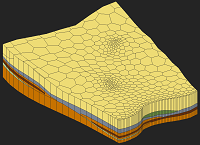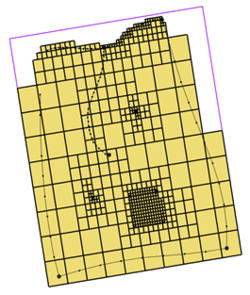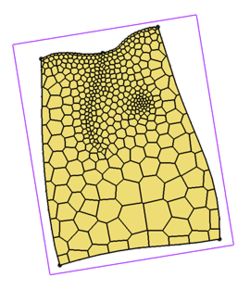GMS:UGrid Module
| UGrid Module | |
|---|---|
 | |
| UGrid | |
| Creating and Editing | |
| Viewing Modes | |
| Converting to Other Data Types | |
| Exporting UGrids | |
| UGrid Interpolation | |
| More | |
| Display Options | |
| Tool Palette | |
| Cell Properties | |
| UGrid Commands | |
The UGrid module is used with unstructured grid (UGrid) geometric objects. Unstructured grids are very flexible. They can include many types of cells including 2D and 3D cells and cells with any number of faces and nodes. This type of geometric object is used with MODFLOW-USG which uses a finite volume approach.
Eventually UGrids will be used for all the things that 2D grids and 3D grids are currently used for. A UGrid is similar to the old 3D grids and meshes available in GMS but much more flexible. UGrids can use any type of cell, meaning cells with any number of faces and nodes. This flexibility allows for more realistic modeling of geologic features such as pinchouts.
Interfaces to the following 3D finite difference models are provided in this module:
The UGrid module support the following types of unstructured grids:
- Regular (not refined) – A grid with rectangular cells that are not refined.
- Quadtree – A grid with rectangular cells that are refined in a quadtree manner around any points, arcs and polygons which specify the refinement attribute and refinement size. The cells surrounding the points, arcs, and polygons are also refined to smooth change from coarse cells to refined cells.
- Nested – A grid with rectangular cells that are refined like the quadtree option, but the surrounding cells are not smoothed.
- Voronoi – A grid with cells of various sizes and shapes which meet the Voronoi criteria. The mesh is refined around points that are marked as refine points based on the specified refinement size. The mesh is constructed to honor all arc geometry. If refinement is specified as an attribute on arcs or polygons it is ignored.
Related Topics
| GMS – Groundwater Modeling System | ||
|---|---|---|
| Modules: | 2D Grid • 2D Mesh • 2D Scatter Point • 3D Grid • 3D Mesh • 3D Scatter Point • Boreholes • GIS • Map • Solid • TINs • UGrids | |
| Models: | FEFLOW • FEMWATER • HydroGeoSphere • MODAEM • MODFLOW • MODPATH • mod-PATH3DU • MT3DMS • MT3D-USGS • PEST • PHT3D • RT3D • SEAM3D • SEAWAT • SEEP2D • T-PROGS • ZONEBUDGET | |
| Aquaveo | ||

